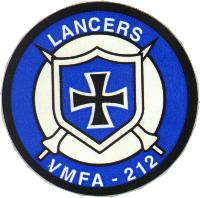
Marine Fighter Attack Squadron 212 was originally activated as VMF-212 the "Hell Hounds" at Ewa Territory of Hawaii on 1 March 1942. Deploying immediately to the South Pacific in their F4F Wildcats, the Hell Hounds engaged the Japanese at New Hebrides, New Caledonia and later Guadalcanal as part of the "Cactus Air Force" at Henderson Field. The Hell Hounds acquired an enviable record by destroying 64 1/2 enemy planes. Of this number, LtCol Harlold "Indian Joe" Bauer, the squadron's first Commanding Officer, was credited with 11 kills and posthumously awarded the Medal of Honor for his valor. The squadron went on to participate in operations off of Midway, Esprit Santo, Treasure Island, Russell Islands, Bougainville and Raboul. During operations in the Philippines in May 1945, the Hell Hounds converted to the F4U-4 Corsair, renamed themselves the "Musketeers", and later supported the American invasion of Okinawa. During WWII, VMF-212 was credited with 132 1/2 enemy aircraft destroyed, countless tons of shipping sunk, and earned 2 Presidential Unit Citations for the Guadalcanal-Tulagi and Okinawa-Ryukyus campaigns.
With the outbreak of the Korean War four years later, 212, now with the designation of a Marine Attack Squadron, was flying combat missions. In September 1951, the Devil Cats became one of the first land based squadrons to conduct operations from Kimpo Airfield near Seoul. For the next 2 1/2 years VMA-212 was continually employed in Korea including flying close air support for the 1st Marine Division's breakout at Chosin Resevoir. With the signing of the Cease Fire Agreement on 27 July 1953, the total number of combat missions flown by 212 was 18,257 with a total flying time of 39,893 hours. The unit remained in Korea until February 1955 when its personnel and AD-1 "Skyraiders" departed onboard the USS Wasp for Hawaii to join the 1st Provisional Marine Air-Ground Task Force.
In the fall of 1958, VMA-212 was deployed to Japan for six months in the first Trans-Pacific crossing of Marine combat aircraft by means other than aboard an aircraft carrier. The unit continued to deploy periodiaclly to the Far East for the next seven years.
In April 1965, the squadron, now known as the "Lancers" sailed aboard the USS Oriskany to the coast of Vietnam to augment the power of the Naval Air arm at Yankee Station. The Lancers flew missions in North and South Vietnam. Later, in April of 1972, the squadron deployed from Hawaii to Da Nang, South Vietnam in an effort to blunt the massive North Vietnamese invasion of South Vietnam. VMFA-212 earned a Meritorious Unit Citation for its effort in Vietnam.
From 1974 until 1987, VMFA-212 deployed numerous times to Japan and the West Coast earning the CNO Aviation Safety Award, the Robert M. Hanson Award, and the Meritorious Unit Citation. During October 1988, VMFA-212 completed its seventh and final rotation in the UDP as an F-4 "Phantom" squadron. With the last F-4 sorties flown in August of 1988, over 23,000 accident-free hours had been accumulated. The F/A-18C "Hornet" was received at this time and continues its outstanding performance today.
On December 10, 1990, the squadron deployed to Bahrain and joined MAG-11 in support of Operations Desert Shield and Storm. From 1 January to 16 January 1991, the Lancers maintanied Combat Air Patrol off the coast of Kuwait and focused on contingency mission planning. In the early hours of 17 January 1991, the Lancers flew their first combat missions since Vietnam. The Lancers participated in a wide variety of missions including Deep Air Strikes, Battle Area Interdiction, Suppression of Enemy Air Defenses, Close Air Support and Fighter Escort. Air Operations against Iraq ceased on 28 February 1991, bringing an end to the most successful air campaign in history.
On 20 May, 1991, the squadron returned to MCAS Kaneohe Bay for routine flight operations. The Navy Unit Commendation was awarded to the squadron for combat operations, and a MUC for security operations after the war. In February 1992, the squadron resumed the UDP cycle and returned to Iwakuni, Japan marking the first Lancers F/A-18's in WestPac. On 26 July 1993, the Lancers departed MCAS Kaneohe Bay for the last time. The squadron deployed to WestPac for six months before moving to MCAS El Toro, California. In February 1995 the squadron returned to Iwakuni before moving again to NAS Miramar on 14 August 1995. For the remainder of 1995 and into 1996 the Lancers continued to support normal operations. On August 13, 1996 the Lancers took off for the final time from NAS Miramar enroute to MCAS Iwakuni, Japan. After a successful six month UDP cycle the Lancers became a permanent resident of MCAS Iwakuni.
The Lancers of VMFA-212 have achieved an enviable record over their 54 year history, and the legacy shall live on as the squadron prepares to enter the 21st Century. The Lancers remain ready to deploy, fight, and win in a manner befitting a true force in readiness as one of the Marine Corps' finest fighter squadrons. From Kaneohe Bay to El Toro, Miramar and to Iwakuni the Lancers have held true to their motto:
TRAIN TO FIGHT, FIGHT TO WIN!
